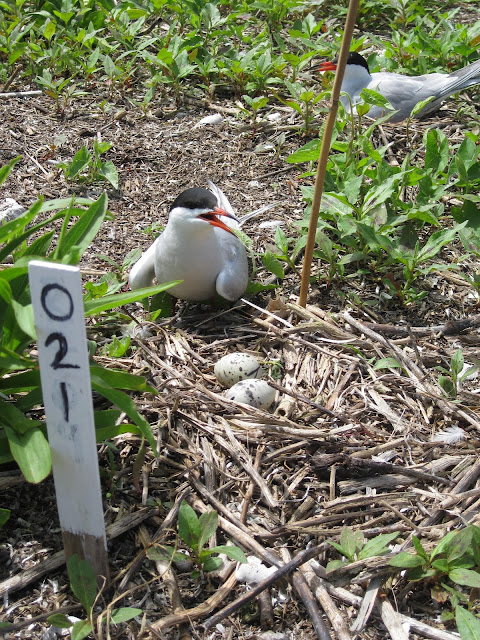 Today you’re hearing from Brett Hillman, a biological science technician for the Service’s New England Field Office, as he recounts his work with shorebirds in Massachusetts. Brett assists the endangered species biologists and has the great pleasure of working with a wide variety of wildlife.
Today you’re hearing from Brett Hillman, a biological science technician for the Service’s New England Field Office, as he recounts his work with shorebirds in Massachusetts. Brett assists the endangered species biologists and has the great pleasure of working with a wide variety of wildlife.
Before May 24, I never thought I could have so much fun and learn so much while being pooped on by hundreds of real-life Angry Birds! That all changed when I had the great pleasure of helping with some field work at a tern colony on Ram Island in Buzzards Bay, Massachusetts.
This work is part of a long-term study of common and roseate terns on Ram, Bird, and Penikese islands, three small pieces of land all in Buzzards Bay that serve as critical breeding territories for these imperiled species.
Roseate terns (Sterna dougallii dougallii) have been federally listed as endangered since 1987, while common terns (Sterna hirundo) are a species of special concern in Massachusetts. Don’t let the word “common” fool you – this species, as well as roseates, are nowhere near as common as they once were. Victims of overhunting, pollution, habitat loss, and predation from exploding gull populations, both species were once at the brink of extinction. Conservation and restoration initiatives have reversed this trend over the last few decades, but there is much still to do.
 |
| Credit: Brett Hillman |
The day started off with the island shrouded in fog, making it too dangerous to approach the rocky shore by boat. After about an hour of patiently waiting on the dock, the fog burned off and Margo Servison, the tern colony manager employed by the Massachusetts Division of Fisheries and Wildlife, intern Justin Dion, and I made our way to Ram Island. As we closed in, I was blown away by the number of terns that were hovering above the island and diving for fish in the sea. I realized I was ill prepared for the thrashing I was about to take!
Shortly after we waded to shore, I was struck in the head for the first of many times by a protective common tern. I looked down and saw my raincoat was already streaked with white blotches. Needless to say, I immediately gained a great deal of respect for Margo and Justin and all of the other folks who dedicate their summers to this thankless work!
The work goes slowly because camouflaged tern eggs are EVERYWHERE – you have to very carefully plan each and every step. We methodically made our way to the survey plots where we counted, weighed, and marked eggs. Margo patiently taught me the process, even though the incessant squawking made verbal communication near impossible.
We also captured a few common terns, which we weighed and measured before we released them. This was without a doubt my favorite part of this whole experience. To capture these birds, we placed a homemade spring loaded trap over a nest and waited for a future parent to walk in. It was quite a thrill to catch a bird in a trap that I set up. This was also the first time I had ever handled a common tern, and they made it very clear that they do not enjoy it!
 |
| Credit: Brett Hillman |
One thing that struck me (aside from the attacking common terns!) was how blasé roseate terns seemed towards defending their eggs, especially compared to how aggressive the common terns were. Roseates vacated their nests as we approached and simply watched from a safe distance while we handled their eggs. At first I wondered, “No wonder these cowardly birds are endangered!” But when I thought about it later, I realized that it’s actually quite an ingenious strategy. By nesting among common terns that viciously and tirelessly squawk, peck, and dive bomb intruders and potential predators, roseate terns can rely on them for protection. This means they spend less time and energy on defense and more on feeding, incubating eggs, and simply resting. Why not let another species do all the work?
We finished at around 3 o’clock and headed back to shore. After a quick dip in the water to rinse off, I was no worse for the wear – with the exception of a mild sunburn on my neck and legs and a small cut on my hand from an especially ruthless common tern. It was an excellent day, and I learned a lot about terns, the efforts in place to protect them, and the field work that is done to monitor them. This was definitely an experience I won’t soon forget.
Check out Brett’s New England Nature Blog to read more about his work and interests.
Nice post. Very interesting and funny. Keep up the great work!
ReplyDeleteThankfully we have people like this that is watching out for our wildlife. Keep up the good work.
Delete